|
Auditorium San Domenico Project: Segni nella Citta
Point/to/Point Nail/to/Nail Wire/to/Wire In/to/Out Open/to/Close Pass/Present Use/Utility Site/Sight Cord/Accord Point/to/Point Location: Auditorium/Ex Church of San Domenico, Foligno, Italy Materials: Steel Cable and Photographic Paper Dimensions: Variable Article: Segni nella cittÓ, in Italian Date: April - May 2004
The History Looking back through the history of art and Italian art in particular, we see the importance in both the aesthetic and civic role played in church art and architecture. Foremost among this activity is the use of the church door or portal as a vibrant subject for artistic endeavor. We can look back, for only one example, at the accomplishment of Lorenzo Ghiberti "Doors of Paradise" for the Baptistery of the Duomo in Florence. The subject of a fierce competition to create an artwork that would equally display the talent and devotion of the artist but express the civic pride that Florence took to be its rightful place in the world. In this way the doors offer the promise, for those who pass, of the many layered rewards of those who control the interior space that the open in towards. Paradise was the subject of another Florentine; Dante who connection with Foligno is rooted in the first printed text of his masterpiece produced here. This connection is not casual and represents another link in our collective histories. In another example, the city uses its own gates or doors to both protect and open itself up to its surroundings. They can be seen a metaphor to express the willingness and state of mind that allows for the equal exchange of ideas and positions regardless of the size of the municipality that offers its forum. Foligno has its own rich and mostly undiscovered history with rich links to many moments in the history of culture of the Western world. Unfortunately most of it is unknown by those outside of the city itself. The Site & The City: Foligno Foligno is unique in Umbria as representing the only true urban city in the Province. With its position on a large flat plain and its combination of historical center and its phases of development including the 1800's as well as the modern post war it displays all the characteristics of a city in a modest, but interesting, scale. The Piazza of San Dominico in Foligno is an exceptional situation that affords the possibility to address a series of issues about the urban experience. First amongst these is the presence of the various structures of different historical eras. Ranging from the Roman through the Medieval and Modern, the buildings articulate the very concept of "strata" or levels that mark the passage of time and gesture in urban life. The oval traffic circle with its large palm trees and light fixtures literarily guides one around to the north end of the piazza. There one is confronted by the unfinished fašade of the ex-church of San Dominico with its large-scale wooden doors seemingly permanently closed. Now functioning as a civic hall and theater, its entrance has been moved to the side access at the rear of building. The piazza and the change of function of the ex-church create for me a proposal of the change in urban fabric where the past is reinvested with meaning by the application of a new function for both the building and its context. The Project The project for the doors/entrance for the ex-church of San Dominico is best articulated by describing the elements of the installation. From various points across the ex-church, stainless steel cable will be strung, intersecting as they transverse the frame from top to bottom and side to side. The stainless steel cable will to affixed to the existing points of nails, rings and other metal elements which have been added to the fašade over its long history. At various points a self-developing photographic paper (Printing Out Paper/POP) will wrapped and keep in place by wire on the intercrossing cables. The paper reacting to the ambient light will "mark" itself by leaving a lighter tone at the point where the cable touches the photo surface. The Concept As I have stated in my introduction the idea of doors and portals have created a powerful image, both visually and intellectually in the history of urban culture. The concept of my installation lies in the creation of an open random grid like structure, represented in the crossing stainless steel cables, that act as a aperture through which one can enter through and access the inner-space of the past (ex-church), present (civic hall) and future (the piazza's planed restoration). The photographic paper held in "tension" represents the important though precarious position of each of us in our attempt to enter these "Doors of Paradise" as members of the contemporary urban mass. We like the photographic paper are "marked" by our/its contact with this structure. We are both the passenger and the guide that make our way in this city that presented Dante and his voyage to the world. |
 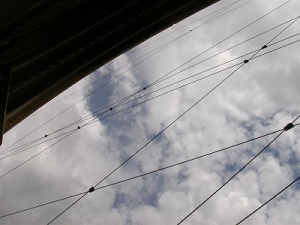 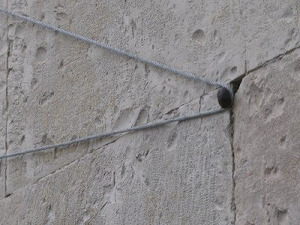 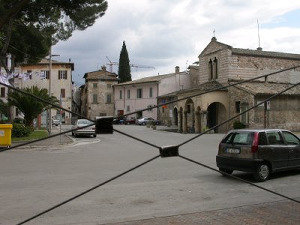  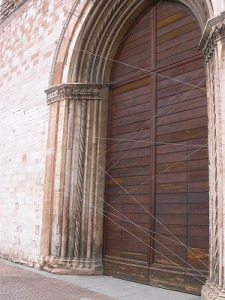 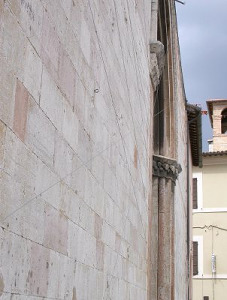 |